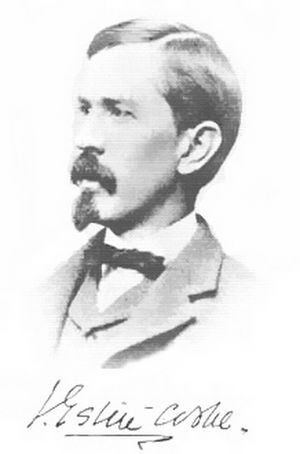John Esten Cooke facts for kids
Quick facts for kids
John Esten Cooke
|
|
|---|---|
 |
|
| Born | November 3, 1830 |
| Died | September 27, 1886 (aged 55) |
| Spouse(s) | Mary Francis Page (1867 – 1878, her death) |
John Esten Cooke (born November 3, 1830 – died September 27, 1886) was an American writer. He was known for writing novels, stories, and poems. His brother, Philip Pendleton Cooke, was also a poet.
During the American Civil War, John Esten Cooke served as an officer in the Confederate States Army. He worked for Maj. Gen. J.E.B. Stuart, a famous cavalry leader. After Stuart's death, he served under Brig. Gen. William N. Pendleton. Cooke was also a first cousin to Stuart's wife, Flora.
Contents
Early Life and Becoming a Writer
John Esten Cooke was born in Winchester, Virginia, on November 3, 1830. He was one of 13 children, but only five lived past childhood. His father, John R. Cooke, was a lawyer and planter.
The family lived on a large farm called "Ambler's Hill" in the Shenandoah Valley. In 1838, their next home, "Glengary," burned down. The family then moved to Charles Town, Virginia, and later to Richmond, Virginia, in 1840.
From Law to Literature
Cooke's father wanted him to become a lawyer. John studied law and even practiced it for a short time in Richmond. However, he faced money problems and could not go to the University of Virginia.
In 1851, he started a law firm with his father. But Cooke loved writing more than law. His writing often took time away from his legal work.
Cooke began publishing his writings between 1848 and 1853. By 1854, he started writing and publishing books. After his father passed away in 1858, he stopped practicing law completely.
He quickly became a successful novelist and short story writer. He wrote 31 books and nearly 200 articles and poems. Cooke became famous for his historical novels about Virginia.
His novels, like The Virginia Comedians (1854) and The Wearing of the Gray, showed life and history in Virginia. The Wearing of the Gray was about the American Civil War. He also wrote The Youth of Jefferson.
Joining the Militia
In the 1850s, Cooke joined the Richmond Howitzers. This was a local militia artillery unit. He became a sergeant.
He went with his unit to Harpers Ferry when John Brown's raid happened. This was an important event before the Civil War.
Service in the Civil War
Cooke fought with the Richmond Howitzers at the First Battle of Bull Run. This was one of the first major battles of the Civil War.
After the battle, Cooke started writing to Southern newspapers. He wrote as "Our Virginia Correspondent." He praised J.E.B. Stuart and pushed for Stuart to be promoted. Stuart was promoted to brigadier general in September 1861.
Working with General Stuart
In early 1862, Cooke volunteered to help Maj. Gen. J.E.B. Stuart. Cooke was a first cousin to Stuart's wife, Flora Cooke Stuart. On May 19, 1862, he officially joined Stuart's staff as a lieutenant.
Cooke took part in the Peninsula Campaign. He also joined Stuart's famous ride around the Union army led by George B. McClellan. Cooke later wrote a detailed description of this daring ride.
He worked as an ordnance officer, managing military supplies, until October 1863. Stuart praised Cooke's service during these campaigns. Stuart was promoted to major general in July 1862.
On June 9, 1863, Cooke and other staff members were involved in fighting at the Battle of Brandy Station.
Gettysburg Campaign and Later Service
Cooke also joined Stuart during the Gettysburg Campaign. Early in Stuart's ride around the Union Army of the Potomac, Cooke almost got captured. He was eating breakfast when Union riders came by. He barely escaped capture.
During the war, Cooke served Stuart as an aide, ordnance officer, and assistant adjutant general. He reached the rank of captain. In October 1863, Stuart made Cooke an adjutant. This was so Cooke could use his writing skills to help with paperwork.
After Stuart died at Yellow Tavern in May 1864, Cooke served under Brig. Gen. William N. Pendleton. By the end of the war, Cooke had become a major.
Life After the War
In 1867, Cooke married Mary Frances Page. They moved to a farm called "Saratoga" near Boyce, Virginia. He became a farmer and gardener, but he also continued to write.
The Cookes had three children. Sadly, Mary Frances died on January 15, 1878, which was a great sorrow for Cooke.
His Later Writings
Even during the war, in 1863, Cooke started writing biographies. He wrote about famous figures like Stonewall Jackson. His biography of Jackson, published in 1876, received some criticism for its mistakes.
He also wrote a novel about Jackson called Surry of Eagle's Nest (1866). Later, he wrote biographies of Robert E. Lee and other officers he knew. These later works were considered more accurate.
John Esten Cooke passed away from typhoid fever at his home on September 27, 1886. He was buried in Old Chapel Cemetery in Millwood, Virginia.
John Esten Cooke Fiction Award
The John Esten Cooke Fiction Award is given every year. It encourages writers to create fiction about the Civil War, Confederate history, or Southern history. The stories must be historically accurate.
This award offers a $1,000 grant. Books are judged on how well they are researched, their accuracy, and their writing style. It is one of three writing awards given by the Military Order of the Stars and Bars.
Images for kids


